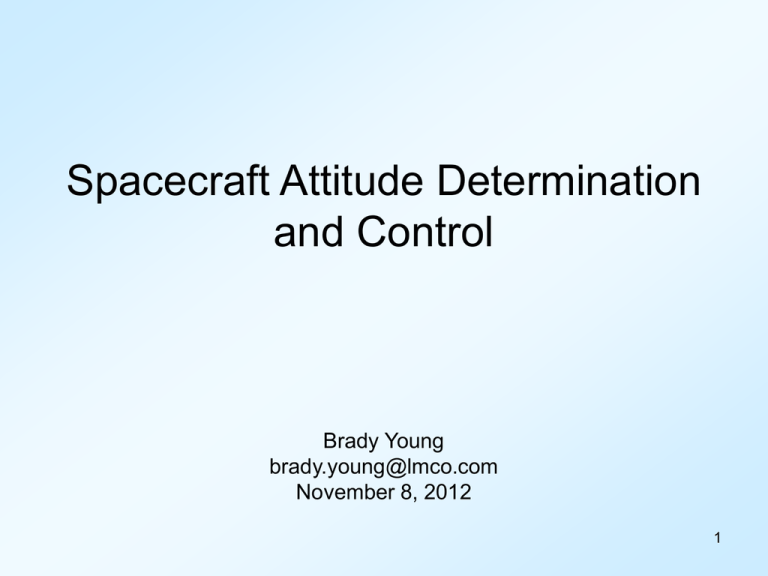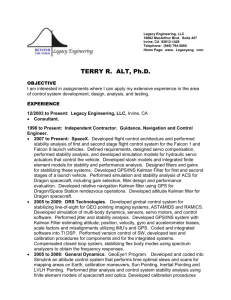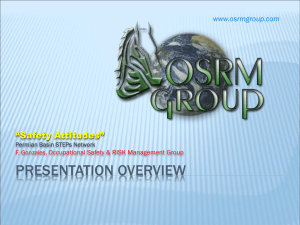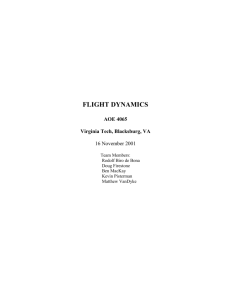Attitude Determination and Control Systems
advertisement

Spacecraft Attitude Determination and Control Brady Young brady.young@lmco.com November 8, 2012 1 What is ADCS? [Attitude Determination and Control Subsystem] “It’s all about orientation” • “Attitude” is the relative orientation of one frame to another – With spacecraft, it always starts with a spacecraft-body-fixed frame relative to an inertially-fixed frame – Anything “pointing” typically falls to the ADCS team to control Fixed to S/C Fixed to stars • Acronym varies: ACDS, ACS, ADC,… 2 Why ADCS is the Best Spacecraft Subsystem • Interconnected with all other subsystems – Must point payloads at targets, COM antennas at ground stations, solar arrays at the sun… • Interesting work in all mission phases – Mission design, S/C design, I&T, commissioning, operations, mission extensions • Nice balance of academic and production-oriented activities – Analysis deeply rooted in theory, but hardware still has to fly! • Interpretive dance in the workplace 3 Part 1: Attitude Determination “Where Am I?” 4 Describing an Attitude • Use your right hand! • There are many ways to represent an attitude: – – – – ZA ZB Euler angles (roll, pitch, yaw) Direction cosine matrices(“DCMs”) Quaternions Modified Rodriguez Parameters & others • Attitude is always relative! Always frame-A-to-frame-B. • Very common for attitudes to be nested: A-to-C = A-to-B, then B-to-C YB YA XA XB 5 Describing Pointing • Usually comes down to a unit vector in a common frame ZN – Example: “The camera’s boresight is [x, y, z] in the ECI frame” ZB YB = [x, y, z]N • Assign convenient coordinate frames to instruments of interest • Then it’s just linear algebra to transform vectors from one frame to the next x T11 T12 T y 21 T22 z N T31 T32 T13 0 T23 1 T33 0 B YN XN XB [T] is DCM describing a transformation from B-to-N 6 AD in Theory Comparing the landmarks seen by your sensors against their known locations Your Map: Your Sensor Sees: • One vector isn’t enough information • Two vectors is too much information • “Triad” is the most simplistic reconciliation – Decide which measured vector you trust more. Call it “vector_A”. – Declare measured_vector_A = known_vector_A – “Swivel” attitude about measured_vector_A until measured_vector_B is as close as it can be to known_vector_B 7 AD In Practice • We almost always collect more data than we need • Estimation: getting a small amount of quality information out of a large quantity of noisy measurements • Least Squares Fitting is used everywhere • Ex: Q-method, Kalman Filter 8 AD Hardware: Sensors • Earth Sensors / Horizon Sensors – • Sun Sensors – • Optical instruments that scan for the CO2 in Earth’s atmosphere When illuminated, report vector to sun Magnetometer – Detects Earth’s magnetic field as a 3D vector • Star Trackers / Star Cameras – • Takes pictures of the sky and maps stars against a catalog Angular Rate Sensors – – – Directly measure rate & direction of rotation vs. inertial space Iron gyros, Ring Laser Gyros, Fiber Optic Gyros “Relative” position measurements, suffer from drift over time 9 Part 2: Attitude Control “Get a Move On!” 10 Common Attitude Targets • Inertial • Nadir Pointing • Orbit-fixed • Earth-target tracking • Spin about an axis (old school) 11 Most Generic Block Diagram Automotive Example “Need to go 5 mph faster” Target Error + “I want to go 50 mph.” Command Controller - “Open throttle 10 degrees!” Plant “State” “Now going 46 mph” Sensor Measurement “The speedometer reads 45 mph” 12 Control Laws The brains of the operation • PID control is by far the most common • Proportional: based on displacement from target (like a spring) – Good for responding quickly to disturbances • Integrator: based on accumulated displacement from target – Good for removing constant “DC” biases • Derivative: based on rate of change (like a damper) – Good for stability – Frequency domain analysis techniques • Bode plots, Nichols plots, … • Pointing, momentum management usually controlled independently 13 AC Hardware: Actuators “A torque is a torque, no matter where it is located” • Thrusters • Reaction wheels • Electromagnetic Torque Rods • Control-Moment Gyros • Passive devices: gravity gradient boom, viscous dampers, aerobrakes 14 Backup 15 Speaking the Language Open Loop Control: sending commands without real-time visibility into their effect Closed Loop Control: commanding that adjusts in realtime based on its measured effectiveness Gains – coefficients that dictate the responsiveness of the system Phase Margin/Gain Margin: measures of stability Bandwidth: what range of frequencies your system responds to Propagation: predicting the state of the system sometime in the future based only on the current state of the system 16 “GNC” • Guidance – “Figuring out where you are” – The job of a sensor – Example: “My speedometer says I’m going 25 mph, but I’d really like to be doing 50” • Navigation – “Your strategy for getting where you want to go” – The job of computers & algorithms – Example: “I’ll cross into the left lane and pass this dump truck” • Control – “Getting there” – The job of actuators – Example: mash pedal to the floor, turn wheel to the left, … 17 Orbits Position and Velocity 18 Orbit Types • Low-Earth Orbit (LEO) – Easy to get to, see lots of parts of the Earth – Ex: Int’l Space Station, GEOEYE • Space debris pic here • Geosynchronous Orbit (GEO) – See the same spot on the ground 24/7 – Ex: Satellite TV • Others: – MEO, HEO 19 Defining Your Orbit Keplarian Orbital Elements • You will always need 7 numbers to uniquely describe an orbit • One of them is always time… the “epoch” • Six orbital elements, or Position and Velocity as 3-element vectors Semi-Major Axis (SMA) Eccentricity Inclination Right Accention of Ascending Node Argument of Perigee True Anomaly YOU ARE HERE 20 Maneuvers • Hohman Transfer – Most fuel efficient way to increase SMA (raise orbit) – Burn in velocity direction at apogee • Higher orbits do fewer “revs” per day – NOT intuitive for formation flying 21 Orbits: Speaking the Language • J2 – The equitorial “bulge” of the Earth • Spherical Harmonics – mathematical parameters to describe the shape of the Earth • Geoid – the gravitational shape of the Earth. The shape of the Earth if it were uniformly dense. • Precession – The slow rotation of the orbit plane about the Earth’s spin axis – Caused by the J2. Rate of precession varies with altitude, inclination • Vernal Equinox – line formed by intersection of Earth’s equator and the plane of Earth’s orbit around the sun 22 Links • http://www.youtube.com/watch?v=dmnmu Tv4pGE 23











